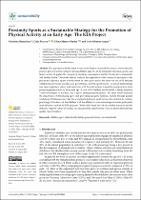Por favor, use este identificador para citar o enlazar este ítem:
https://repositorio.usj.es/handle/123456789/1016
Registro completo de metadatos
| Campo DC | Valor | Lengua/Idioma |
|---|---|---|
| dc.contributor.author | Barrachina, Valentina | - |
| dc.contributor.author | Marcen, Celia | - |
| dc.contributor.author | Mainer Pardos, Elena | - |
| dc.contributor.author | Arbones-Arque, Irela | - |
| dc.date.accessioned | 2023-11-20T13:36:24Z | - |
| dc.date.available | 2023-11-20T13:36:24Z | - |
| dc.date.issued | 2023-08-06 | - |
| dc.identifier.citation | Barrachina, V.; Marcen, C.; Mainer-Pardos, E.; Arbones-Arque, I. Proximity Sports as a Sustainable Strategy for the Promotion of Physical Activity at an Early Age: The KIA Project. Sustainability 2023, 15, 12043. https://doi.org/10.3390/ su151512043 | en_US |
| dc.identifier.issn | 2071-1050 | en_US |
| dc.identifier.uri | https://repositorio.usj.es/handle/123456789/1016 | - |
| dc.description.abstract | This paper presents the main results of the Kids in Action (KIA) project, which aimed to promote physical activity and sport among children aged 3 to 11, by linking the education, sports, and family sectors. It applies the concepts of proximity consumption and the 15-min city to sustainable and healthy habits. This study aims to evaluate the application of the concept of proximity to the provision of physical sports activities from an early age to reduce the drop-out rate of PA through collaboration between schools, local government, and the sports sector. A mixed methodology was used, applying a survey and interviews with the stakeholders to identify good practices when promoting physical activity at an early age. A total of 147 children and 10 adults (3 family members, 4 school managers or teachers, and 3 sports managers) participated. The main results included the importance of introducing sport and providing adequate facilities, namely through guided workshops. It influences not only the actual participation in sport but also the intention to continue practicing it. It is observed that children with less affinity for conventional sports benefit particularly from initiatives such as the KIA program. On the other hand, the lack of available resources and the influence of sports culture in families are considered the main barriers. They are factors that harm the quality of participation. | en_US |
| dc.format.extent | 17 p. | en_US |
| dc.format.mimetype | application/pdf | en_US |
| dc.language.iso | eng | en_US |
| dc.publisher | MDPI | en_US |
| dc.relation | This research was funded by the European Commission, grant number 622130-EPP-1-2020-1-PT-SPO-SSCP. | en_US |
| dc.rights | Atribución 4.0 Internacional | * |
| dc.rights.uri | http://creativecommons.org/licenses/by/4.0/ | * |
| dc.subject | Children | en_US |
| dc.subject | Sport clubs | en_US |
| dc.subject | Healthy habits | en_US |
| dc.subject | Physical activity | en_US |
| dc.subject | Mixed methods | en_US |
| dc.title | Proximity Sports as a Sustainable Strategy for the Promotion of Physical Activity at an Early Age: The KIA Project | en_US |
| dc.type | journal article | es_ES |
| dc.identifier.doi | https://doi.org/10.3390/ su151512043 | en_US |
| dc.rights.accessRights | open access | es_ES |
| Aparece en las colecciones: | Artículos de revistas | |
Ficheros en este ítem:
| Fichero | Descripción | Tamaño | Formato | |
|---|---|---|---|---|
| Proximity Sports as a Sustainable Strategy for the Promotion of Physical Activity at an Early Age.pdf | 827,69 kB | Adobe PDF |  Visualizar/Abrir |
Este ítem está sujeto a una licencia Creative Commons Licencia Creative Commons

